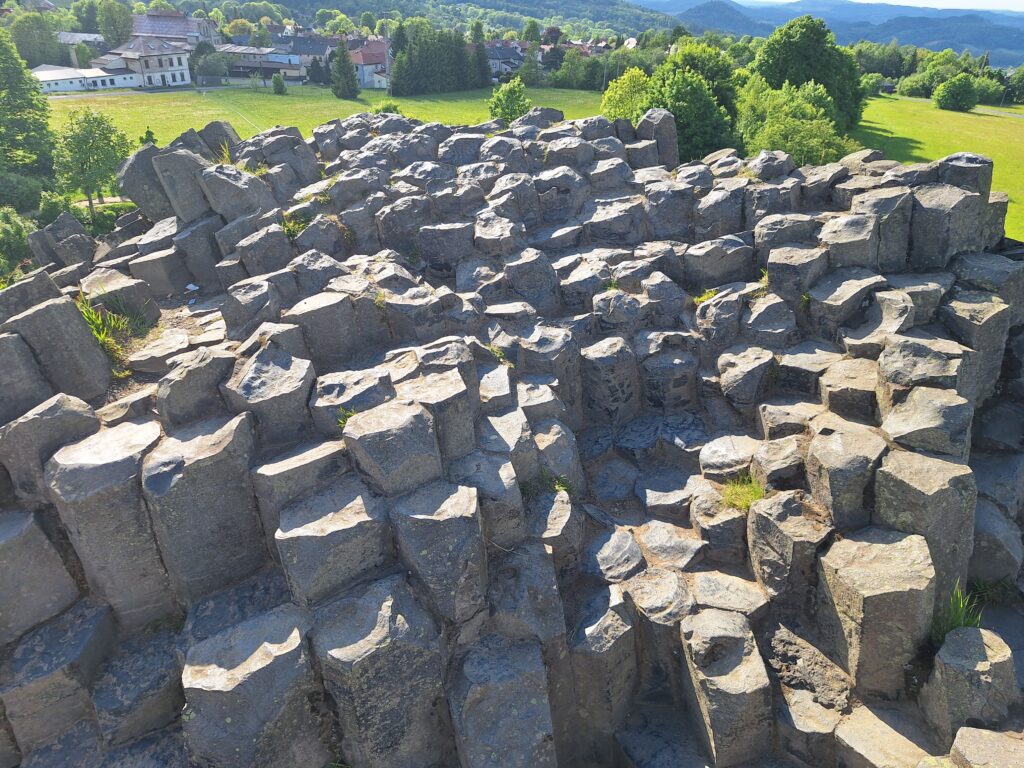Reading Time: 2 Minutes 55 Seconds
General info
Panská skála is a remnant of a small basalt rock hill of 597 meters, which protrudes from the plateau between Kamenický Šenov and Prácheň, in the Liberec region, north of the Czech Republic.
The rock formation of Panská skála is connected to the impact of the African continental plate with the European one during the Mesozoic and Cenozoic eras.
During the volcanic activity of that period, the magma of the basaltic composition pushed upwards and the slow cooling and solidification process created the pillars.
At Panská skála you can admire a collection of pentagonal and hexagonal columns, that are arranged vertically and at angles, placed next to each other.
The whole body resembles the pipes of an organ, which is why it is often called the stone organ (kamenné varhany, in Czech).
The length of the columns reaches up to 15 meters and the diameter of each is about 20-40 centimeters.
If you are familiar with the Giant’s causeway in Northern Ireland, or with Reynisfjara beach in Iceland, then Panská skála is a tinier version of it.

Panská skála has a romantic aspect and from the top you have a beautiful view of the surroundings.
The nearby Zlatý Vrch (the Golden Hill) is another less known, yet still quite fascinating basalt rock.
A treat: the legendary scenes of the film “Pyšná princezna” (The Proud Princess) were shot in Panská skála. Here you will find an excerpt from the film.
Saving Panská skála
Today, Panská skála has the status of a National Natural Monument and the protected area is 1.26 hectares.
It is the most visited geological formation in the Czech Republic, well known even to geologists abroad.
It must be remembered, however, that today’s conformation of Panská skála is not only the result of natural processes, but human intervention has contributed to shape the rock too.
When the hill was discovered at the end of the eighteenth century, mining began to extract basalt.
Given the uniqueness of the site, the first ban on the extraction appeared as early as 1895, but it was not respected.
In 1902, the Association for the Rescue of Panská skála was founded aimed to raise funds to purchase the quarry.
To achieve this goal, the association organized various fundraising activities, including collections, lotteries, charity balls, and the sale of souvenirs.
Finally, in 1904 the association bought the top of the rock to prevent mining.
However, mining continued in the space in front of the quarry and it is in that depression that a small rainwater lake stands nowadays.
Only after numerous interventions the mining activities ceased in 1913, and the extraction of stones was banned throughout the entire Panská skála area.
In 1914 the rock was bought by the Česká Kamenice district committee and it has been protected ever since.
How to get there
By car or bike it is the best and fastest way. There is a parking area few hundreds meters from Panská skála.
Cars pay 50kč per hour. Motorcycles and bikes have free access and by bike you can get to the rock itself.
In the parking area you find free toilets and the infocentre.
At the corner of the house in front, they sell coffee, ice-cream and small snacks.
If you travel by public transport, don’t lose hope!
By starting early in the morning, or by planning a weekend out, you can reach and see Panská skála by train or bus too.
There are several options, the best ones include a hiking excursion.
- Get a train or a bus to Nový Bor and from there walk 8 km following the blue signs.
- Get a train or a bus to Česká Kamenice and then hike for 7.5km following the green path.
If you are lazy, from both Nový Bor and Česká Kamenice there are buses to Panská skála. The closest bus stop is called “Kamenický Šenov, Prácheň”.
Check out the timetables on Pubtran before you travel, especially on weekends and in winter.

